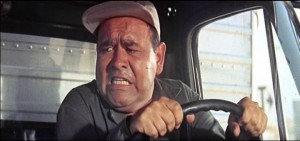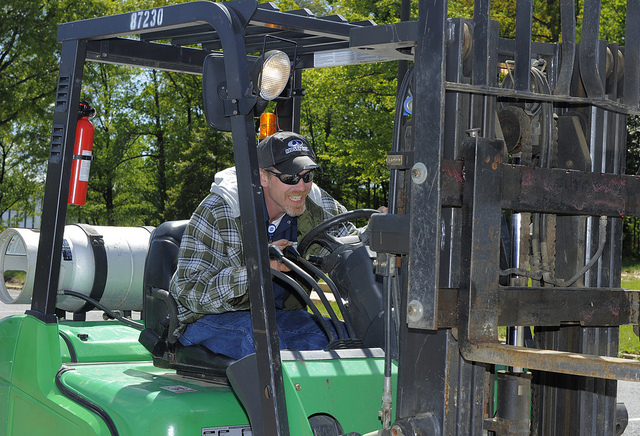There is No Driver Shortage: Only a Pay Shortage
 Do you know how you can tell when management is out of touch with reality? When their lips are moving. That may be a joke, but it’s always amazing to me when years, even decades pass, and yet many still believe the same old crap about a driver shortage. They have numbers too, which make it seem true. But those numbers tell a different story if you just step back and look at the big picture.
Do you know how you can tell when management is out of touch with reality? When their lips are moving. That may be a joke, but it’s always amazing to me when years, even decades pass, and yet many still believe the same old crap about a driver shortage. They have numbers too, which make it seem true. But those numbers tell a different story if you just step back and look at the big picture.
Maybe it’s because I am a career trucker, and have developed a habit of seeing the big picture. It’s what truck drivers are taught since day-one. But, I’ve known for 30-years that there has never been, and never will be a driver shortage. So, every year or so, when these stories of driver shortage pop up, I yell at the radio.
Supposedly, there is work for 20,000 to 30,000 drivers right now. And, we will need 110,000 more drivers by 2014.
But I say that is simply not true. OK, maybe the numbers show a need for drivers overall. But the fact is, the competitive nature of the trucking industry allows for supply-and-demand.
In other words, customers are not having any trouble finding a truck any time they need one. Until that starts to happen, there is no shortage of drivers. Every day in this country there are thousands and thousands of truckloads moved. Trucking companies are under-bidding their competition and learning how to operate on less capital, so they can run cheaper. In other words, it’s very competitive.
If there was a driver shortage, it would be completely the opposite:
Instead of companies under-bidding each other, they would hold out for more money. People would be having a hard time finding a trucking company willing to haul their freight. This is why a lot of companies really wish there was a driver shortage- then rates would skyrocket, and loads would be plentiful. But anyone in the industry knows darn well, that ain’t happening.
There is a battle for market share among trucking companies, and a battle for better jobs among drivers. But again, it’s more about supply-and-demand than anything else.
If trucking company A pays more than trucking company B, a driver will likely move on. The same with freight- why should a customer pay $900 when someone else will do it for $450? Supply-and-demand controls the market- freight rates, and driver pay.
But just like companies who will haul that cheap freight, there are drivers out there willing to work for that low wage. And, therein you have the real problem.
Just look at this crap. These are major trucking and/or news outlets reporting this phoney driver shortage:
- The American Trucking Association (ATA) has a whole section of material dedicated to the study of driver shortages and what to do about it.
- Journal of Commerce takes an in-depth analysis at the numbers, and even has a fancy driver shortage infographic.
- Bloomberg reports on what companies are doing about the driver shortage. It’s basically just some tips about how to run a successful trucking company.
Here’s the only one that gets it – TruckingTruth.com. They make the excellent point- it’s more about a company’s turnover rate than it is about a so-called driver shortage.
Many trucking companies struggle with over 100% driver turnover rate. But many trucking companies do not. That’s the big secret. There are thousands of trucking companies out there that pay their drivers well, give them nice equipment, and treat them like the common sense geniuses they are. The ones that don’t get that, and still pay their drivers the same thing they did in 1990 are the ones struggling with a phoney driver shortage.
What’s worse is- even some drivers buy it. If you are a driver and you are reading this, the most important thing to get is- set your sights on higher pay. And if you are a trucking company- don’t haul cheap freight.
Driving is like life. Mike Ditka always used to say how football was like life- and it is. But driving is even more like life. We all walk through life in our own way. Some of us drive through. But we all move on to bigger and better things as we go along.
Share with Friends:
Related Posts
-
 Being a Trucker and Balancing Family Life
No Comments | Dec 6, 2012
Being a Trucker and Balancing Family Life
No Comments | Dec 6, 2012 -
 Forklift Driver’s Worst Nightmare: True Story
1 Comment | Jan 31, 2015
Forklift Driver’s Worst Nightmare: True Story
1 Comment | Jan 31, 2015 -
 Legal Ramifications of a Hit and Run
No Comments | Jul 20, 2013
Legal Ramifications of a Hit and Run
No Comments | Jul 20, 2013 -
 Top Road Rage Excuses – Documented Evidence
5 Comments | Oct 11, 2016
Top Road Rage Excuses – Documented Evidence
5 Comments | Oct 11, 2016

perhaps you could list those companys that offer above .40 a mile and consistantly 3000 miles a week to a 16 yr veteran as an otr driver ? I dont believe they exist !
It’s pretty hard to find both- a good CPM and consistent high miles. However, I recommend Heartland Express for a high rate per mile. With your experience they will likely pay you around 45 cpm, maybe even more. You’ll likely average around 2500 miles a week though. But at that rate you’ll still make good money. Anyway, who wants to work that hard? I’d rather make $1200 running 2500 miles than make $1200 running 3000 miles.
The best jobs are the ones that don’t advertise. Check your local Yellow Pages and make a few phone calls. Depending on where you live, you just might find it. Or, consider buying a truck. Once you go owner-operator, you’ll never go back.
You only mentioned competition from within the trucking industry, which is very stiff. But what about competition from the railroads? How much business have motor carriers lost to railroads over the last 10 years or so? I’ve noticed that carriers like J.B. hunt, Schneider, fedex and cr england are all using railroads to move their trailers/containers. Any move over 500 mi is within earshot of the railroads to swipe from OTR drivers. And with the advent of regional intermodal unloading facilities, railroads have reduced some moves to regional hauls for drivers vs a long haul move. And that’s the good part. If the railroads tried, they could cut out truckers altogether by luring a shipper into using a boxcar or other railcar depending on the load. If that happened, the only area for a truck to get in on the move would be the last 50 or so miles. And this is assuming the receiver doesn’t have a rail spur. If the receiver has a rail spur, trucks could be cut out altogether from that particular move. I’d like to see drivers get more pay but ever since the trucking and railroad industries were deregulated, the competition amongst these two makes this impossible.
Great point. Railroad is a huge segment of the industry. I don’t know enough about it to comment on percentages, but I know a lot of big carriers use railroad more and more.